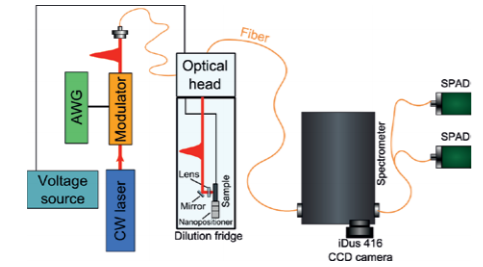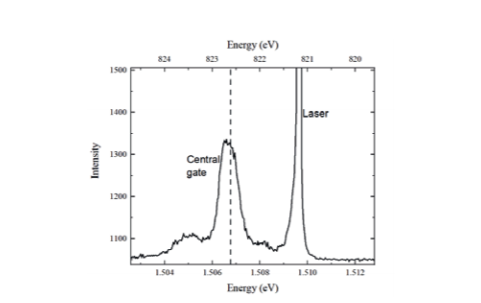Resources
 Part of the Oxford Instruments Group
Part of the Oxford Instruments Group
Expand
Collapse
 Part of the Oxford Instruments Group
Part of the Oxford Instruments Group
Gate defined quantum dots (GDQDs) based on AlGaAs/GaAs heterostructure have been extensively studied as a platform for spin qubits [1]. However, until now, little work has been done to couple the GaAs GDQD to optical photons, which would open up new possibilities for realizing semiconductor-based quantum networks [2]. To solve this problem, we developed a new type of optically active GDQD which can potentially act as an interface between the photons and the spin qubits in standard GDQDs. These optically active GDQD uses local electric fields to confine excitons. The characterization of such QD requires a unique and versatile setup that is capable of performing optical measurement at milli-Kelvin temperature.
To characterize the optically active GDQD, we built a confocal microscope based on a dilution fridge (see details in Figure 1). The sample is kept in a dilution fridge that can reach ~30 mK and optically pumped by a programmable laser pulse sequence generated by modulating the CW laser with a fast modulator. The QD is formed by applying proper voltages to two nanoscale gates (see Figure 2(a)). The photoluminescence from the GDQD is collected through a fiber, sent to a spectrograph (FHR 1000 from Jobin-Yvon) and recorded by a CCD detector (iDus DU416A-LDC-DD from Andor Technology). Combining the small pixel size of the camera (15 um) and long focal length of the spectrograph (1 m), a high spectral resolution (10 pm) is obtained. The single photon purity of the GDQD is measured by performing photon correlation measurement with two single photon detectors. The possibility to control the iDus 416 CCD detector via various programming languages allows us to fully automatize the whole setup, in our case, using a Python script.

Figure 1. Confocal microscope based on a dilution fridge.
Figure 2(b) shows the PL spectrum from the optically active GDQD. The spectrum was measured at 30 mK and recorded by the iDus 416 CCD detector. The thermoelectric cooling technology used by the camera, on the one hand, ensures low dark current that is sufficient to measure weak signal from single QDs; on the other hand, allows us to perform measurements for days without interruption.

Figure 2. (a) STM image of the optically active GDQD.

Figure 2 (b) The PL spectrum of the opticaly active GDQD measured at 30 mK.
[1] E. A. Chekhovich, et. al, Nat. Materials. 12,494 (2013)
[2] B. Joecker, Physical review B 99, 205415 (2019)
Date: 10/12/2020
Author: Dr. Feng Liu and Prof. Hendrik Bluhm, JARA-FIT Institute for Quantum Information Forschungszentrum Jülich
Category: Application Note
